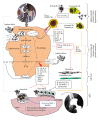The pathology of orthopedic implant failure is mediated by innate immune system cytokines
- PMID: 24891761
- PMCID: PMC4033543
- DOI: 10.1155/2014/185150
The pathology of orthopedic implant failure is mediated by innate immune system cytokines
Abstract
All of the over 1 million total joint replacements implanted in the US each year are expected to eventually fail after 15-25 years of use, due to slow progressive subtle inflammation at the bone implant interface. This inflammatory disease state is caused by implant debris acting, primarily, on innate immune cells, that is, macrophages. This slow progressive pathological bone loss or "aseptic loosening" is a potentially life-threatening condition due to the serious complications in older people (>75 yrs) of total joint replacement revision surgery. In some people implant debris (particles and ions from metals) can influence the adaptive immune system as well, giving rise to the concept of metal sensitivity. However, a consensus of studies agrees that the dominant form of this response is due to innate reactivity by macrophages to implant debris where both danger (DAMP) and pathogen (PAMP) signalling elicit cytokine-based inflammatory responses. This paper discusses implant debris induced release of the cytokines and chemokines due to activation of the innate (and the adaptive) immune system and the subsequent formation of osteolysis. Different mechanisms of implant-debris reactivity related to the innate immune system are detailed, for example, danger signalling (e.g., IL-1β, IL-18, IL-33, etc.), toll-like receptor activation (e.g., IL-6, TNF-α, etc.), apoptosis (e.g., caspases 3-9), bone catabolism (e.g., TRAP5b), and hypoxia responses (Hif1-α). Cytokine-based clinical and basic science studies are in progress to provide diagnosis and therapeutic intervention strategies.
Figures



References
-
- Wright TM, Goodman SB. Implant Wear in Total Joint Replacement: Clinical and Biologic Issues, Material and Design Considerations. Rosemont, Ill, USA: American Academy of Orthopaedic Surgeons; 2001.
-
- Kurtz S, Ong K, Lau E, Mowat F, Halpern M. Projections of primary and revision hip and knee arthroplasty in the United States from 2005 to 2030. Journal of Bone and Joint Surgery—Series A. 2007;89(4):780–785. - PubMed
-
- Herberts P, Malchau H. Long-term registration has improved the quality of hip replacement: a review of the Swedish THR Register comparing 160,000 cases. Acta Orthopaedica Scandinavica. 2000;71(2):111–121. - PubMed
-
- Robertsson O, Knutson K, Lewold S, Lidgren L. The Swedish Knee Arthroplasty Register 1975–1997: an update with special emphasis on 41,223 knees operated on in 1988–1997. Acta Orthopaedica Scandinavica. 2001;72(5):503–513. - PubMed
-
- Boehler M, Plenk H, Jr., Salzer M. Alumina ceramic bearings for hip endoprostheses: the Austrian experiences. Clinical Orthopaedics and Related Research. 2000;(379):85–93. - PubMed
Publication types
MeSH terms
Substances
Grants and funding
LinkOut - more resources
Full Text Sources
Other Literature Sources
Miscellaneous

